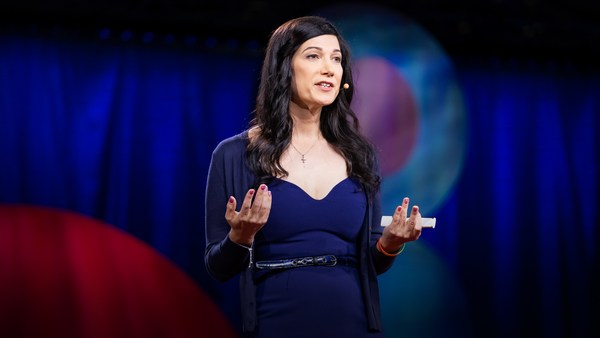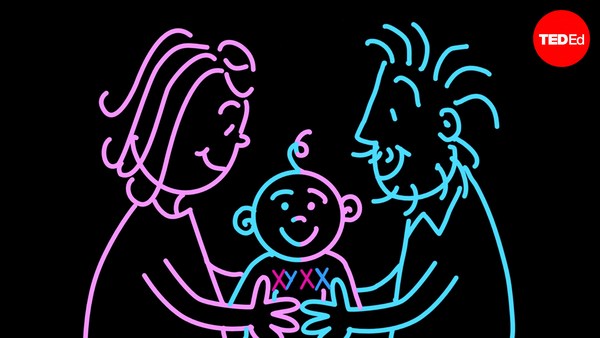OK. So we are going to start in 1891, when a German scientist was looking through a microscope at insect cells. And he saw something kind of funny. At the center of the cells, there was this dark stuff. No one had ever seen it before. And he noticed that as the cells would multiply and divide, it would go into some of the new cells but not the others. He didn't know what it was, so he gave it a really great name. He called it the "X element."
(Laughter)
And he was like, "We'll just fill in that X later."
And then, fast-forward 10 years later, and there is an American scientist, and she is looking through her microscope, also at insect cells. And she sees something funny. There's more of this dark stuff. And it's kind of tiny, it's hanging out near the X element. And eventually, someone was like, "Well, if that one thing's called X, should we call this other thing Y?" And like that, (Snaps fingers) the sex chromosomes had been discovered.
So chromosomes, you probably all know what they are, but I will tell you anyways. They're made up of DNA -- everything has it, it's the blueprint of life, we've got rats, we've got trees, we've got insects, we've got humans. And in the case of human chromosomes, geneticist Melissa Wilson broke it down for me like this.
(Audio) Melissa Wilson: Typically, you'll get one copy of every chromosome from your genetic mom and one copy of every chromosome from your genetic dad, and we have 22 of these that you get one copy from mom and one copy from dad. And then there's a 23rd pair, X and Y.
Molly Webster: So while all the other chromosomes are numbered, one through 22, we do not call X and Y 23. I like to think that they are waiting for, like, a LeBron James to come along. But in this instance, they were like, "We're just going to keep the letters, and then we'll give them a title." They called them the sex chromosomes. Now I would wager that in the United States, these are the most well-known chromosomes for one simple fact: that we say X equals "girl," and Y equals "boy" -- that they are responsible for sex.
And -- and I had to learn this -- but when I'm talking about "sex" here, I'm talking about the way biology gives us gonads, which are our ovaries and our testes -- I'm not talking about gender, which is how we identify. And so, as a reporter at the show -- "Radiolab," the audio documentary program I work for -- I was like, what's up with these sex chromosomes? You know, that's kind of my job, I think things are weird, and then I get to call people about them and ask questions, and then hopefully they answer. And in this case, a lot of people answered.
And in the two years I had of reporting on X and Y, as part of "Gonads," the series on sex and gender I ended up doing for "Radiolab," I found out that these two chromosomes live in a world that is unexpected, a little unsettling; where things that I thought were facts were, like, twisted in ways I hadn't seen before. And the world goes so far beyond the boundaries of sex, I was like, "Maybe we should all talk about this." So, you're you all, we're all going to talk about it.
And for me, the true story of X and Y starts with their name. So within years of being discovered, these two little chromosomes had acquired more than 10 different names. There was diplosome and heterochromosome and idiochromosome, and most of the names had to do with their structure, their shape, their size. And then there was "sex chromosome," which they had been given because of the fact that we had started seeing that the X would go with the females, and the Y would often go with the males. But scientists were like, "Do we really want to call them sex chromosomes?" And science historian Sarah Richardson is the one who told me this story.
(Audio) Sarah Richardson: For three decades, scientists were like, "You should not call them the sex chromosomes. The X and Y have many functions, and you wouldn't assume that a single chromosome controls a single trait. Imagine calling one chromosome the 'urogenital chromosome,' or the 'liver chromosome.'"
MW: Scientists, if you dig into the history -- it's really cool, you should -- were hesitant to, like, commit to such a specific name and such a powerfully connotated name. There was a fear that it would actually be really limiting -- maybe to science, maybe to society -- but the fear was in the room. And you can see they ended up getting "sex chromosome" -- it's like a pretty juicy title, it popularized genetics, you know? But in the 100-year history since we settled on that name, you can see it starts to get a little complicated.
So around 1960 -- this is going to be our first stop on the complicated world of the sex chromosomes -- so around 1960, we had discovered that you could be XYY. They discovered an XYY man. And to digress a little here, it turns out that the model of "X equals girl and Y equals boy" is really simplistic. You can actually be a whole bunch of different combinations of X and Y, giving you, like, different types of biological sex. You could be two Xs and two Ys together. You could be four Xs, you could be five Xs, you could be XO. And so I thought that was pretty crazy, because I was like, "Wow, this really upends a model of biological sex I think most of us in this room have been taught." So a few years after they realized that you can be XYY, researchers go to a prison in Scotland, and they do genetic analysis of a bunch of the male prisoners. And they find a number of people who are XYY. And according to Sarah:
(Audio) SR: They just rushed to publish a theory suggesting that this extra Y chromosome could explain criminality in some men.
MW: Yeah. So the logic goes like this: By this point, we're thinking Y is male. We think male is aggressive, so Y must be aggression. If you've got an extra Y, you must be crazy. And like, we went nuts with this theory. We called it the supermale, they started scanning more prisoners, serial killers, boys. And in all seriousness, there was actually a suggestion that we consider aborting XYY fetuses.
So in 1980, this theory pretty much toppled, for a number of reasons. One, there had been this really large study that basically showed there was no connection between Y and violence, I think we all saw that coming. And then, there was one other thing.
(Audio) SR: Going back and looking at those original findings in that high-security psychiatric institution, they had also found a high number of individuals with an extra X chromosome. So these are XXY, as opposed to XYY.
(Audio) MW: Really?
(Audio) SR: Yeah. Now, they never claimed that the individuals with an extra X chromosome were superfemales. They never investigated whether they had higher rates of violence.
MW: Seems like kind of an oversight. I don't know. But I think it's interesting, because what you see is if you start looking at these chromosomes through the lens of sex, what naturally falls in place behind is we look at them through the lens of gender, and the traits that we associate with gender. So men were violent, and Y explained why they were in prison. The X did not do that, because like, you know, what's X? We don't associate it with violence. And while we don't believe in supermales today -- God, I hope we don't -- we don't believe in supermales today, there is a very similar conversation that's still happening around inherent violence in boys and biology.
So my next stop on the weird world of X and Y, or things feeling a little topsy-turvy, is 1985. The World University Games were set to happen in Japan, and the Spanish hurdler María José Martínez-Patiño was scheduled to run. She was like a hot shot, a rising superstar. And the night before her race, they had her DNA scanned. Now at the time, this was a thing that they were doing, because they were like, "OK, we don't want men covertly racing as women, so we're going to scan the women and make sure all their Xs line up." And so I heard this story from Ruth Padawer who was a New York Times Magazine reporter and she reported on María.
(Audio) Ruth Padawer: So they tell her the chromosome test results were abnormal. Although on the outside, she was fully female, she had XY chromosomes and these internal testes.
MW: They were like, "We hate to break it to you, María, but you're actually a dude. You can't race with the ladies."
(Audio) RP: And so she's thrown off the national team, she's expelled from the athletics residence, she's denied her scholarship, a bunch of her friends dump her, fellow athletes abandon her, she loses her medals, her records are revoked.
MW: So it turns out -- remember when I told you you can be a bunch of different combinations of X and Y -- you can also be XY and be female. You can be XX and male.
In María's case, she was something called androgen insensitive. Which means that she did have some sort of internal testes -- they were making testosterone -- but her body couldn't use it. And so if you thought of testosterone as, like, a superpower, she was not benefiting from it. And so eventually, sports authorities, like, let her back in, but her career was done.
And in this instance you see how, if you assign sex to a specific place in the body, or at least, like, this is what I saw, right? If you assign sex to a specific place in the body, it somehow makes us think that we can go into a body, look at a specific place and tell someone we know something more about them than they know about themselves. And that feels terrifying to me.
And we don't genetically test female athletes anymore, but you can see very similar conversations happening when we talk about testosterone in sports, you can also see it in suggestions that we take transgender individuals and we genetically analyze them and we tell them who they are. That is real, that is a conversation that has happened recently.
The last place that I'll share with you where these chromosomes got complicated for me is this one thing that Melissa told me.
(Audio) Wilson: You can't survive without an X chromosome. No matter your gonads, no matter your identity, every single human being has to have an X chromosome, because without one, the rest of your body doesn't develop.
MW: Why do we call this the female chromosome? OK, this is something I had never though about, but literally, every single person in this audience has an X chromosome, I'm not lying. Every single person on the planet has an X chromosome, but no one is going around like, "This is the every-person chromosome." You know? Like, somehow it's over here, the Y is over there, and they must be really different, and I'm just like, it would be so much better if it was the every-person chromosome. And not just because I'm like, love you all and I want you all in, but because of what we're overlooking by the fact that we consider it female.
Because I'm going to tell you one of the craziest things I found out. Which is, when you think about the X chromosome, of the almost 1,100 genes on the X chromosome, how many do you think have to do with sex and reproduction? Like, get a number in your head. Four percent. That means 96 percent of the rest of that chromosome is doing something that has nothing to do with your gonads.
And I guess as all of these, sort of, some of them social stories, some of them scientific stories, some of these facts, started to add up, I just thought, like, why are we calling these the sex chromosomes? Or if we are, like, maybe we all like that name, should we just allow ourselves to think about them a little more broadly?
Because if we do, like, what insights would we gain, as people, as scientists? And we're at this point where we're thinking about, like, how do we want to teach science, what do we want to fund, like, who do we want to be as a society, you know? And I just wondered if it wasn't a moment to rethink the biology of X and Y, and at the very least, to remember, like, the footnotes of history, which is that the dude who came up with the phrase "sex chromosome," actually was like, "Hey, everyone, just remember, this is just," and I quote, "a form of shorthand." We should not take it literally.
Thank you.
(Applause)





